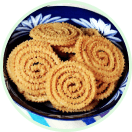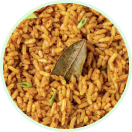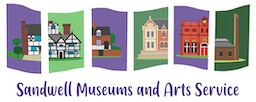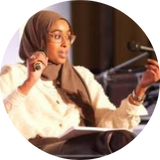Welcome to
LEARNING WITH GRANDAD
THE JOURNEY
‘It is important to encourage people to question things they are not aware of and for people to be open to being asked questions, because everyone is learning.’
The We Don’t Settle curator programme delivered in partnership with Wednesbury Museum and Art Gallery, started in 2021, wants to extend the walls of the museum to its local community. For this purpose, we involved local young people to creatively respond to the museum’s collection of artefacts and curate a heritage output. The Curators explored the artefacts housed at Wednesbury Museum and Art Gallery and focused on the ones connected to communities of colour, which are not currently displayed. As you’ll discover in episode three, Helen Caddick travelled the globe, writing about her experiences whilst collecting cultural objects.This was during a period of British colonial rule.
The young curators, Abdul Saidi Arjun Gogna, Barbara Joni, Bilal Akhlaq, Chanelle Patrice Avey, Edward Williams, Imani Olivia Rowe, Kiayalyi Ayre, Laudy Samra, Monovi Prince, Reanice Lindsay, Sanne Chiza Blanco, and Trixiebella Suen all contributed ideas that have informed the animation series.
The curators Sanne Chiza Blanco and Edward Williams are fine artists, who took ‘Learning with Grandad’ from ideation to production. Sanne and Edward want to address the stigma of not knowing, through the inquisitiveness and boldness of a child’s curiosity.






LEARNING WITH GRANDAD
Museums have artefacts in their collections that gather dust, but the medium of animation enables their stories to be told and different identities’ cultural heritage to be represented. Experience two exhibitions through animation, learn about Helen Caddick’s travels and engage in current questions about artefacts in museums.
Journey with Sipho and his Grandad, Pedro, on their visit to heritage sites. This short animation series creatively responds to cultural artefacts donated by Helen Caddick in Wednesbury Museum & Art Gallery’s collection. We welcome you to collaborate by sharing any stories or thoughts you have about the cultural artefacts and themes explored in the episodes.
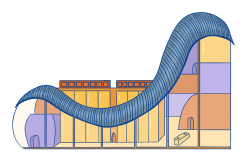
EPISODE 4
Colonisation, Artefacts and Museums
Sipho and Grandad visit a heritage house inspired by Indian cultural heritage, Sipho spots what looks like a prayer mat and tapestry. Learn the history of carpet weaving in India with Sipho and Grandad.
“I had a lot of questions after our visit to the archives yesterday. What’s Colonisation and why does that matter to museums? Grandad says he’ll help me figure it all out.”
DID YOU MISS THIS?
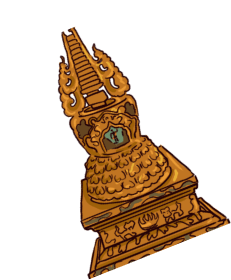
EPISODE 1
Stupa
Sipho and Grandad visit an exhibition on Buddhism and they encounter a stupa, the physical representation of the Buddhist’s mind. Learn along with Sipho as Grandad Pedro tells the story of this particular stupa.
“Me and Grandad are visiting an exhibition today. Its my first one. We’re looking at something called a stupa which grandad says is from the Buddhist faith in Tibet. I don’t know much about it but I’m excited to learn more”.
EPISODE 2
Prayer Mat
Sipho and Grandad visit a heritage house inspired by Indian cultural heritage, Sipho spots what looks like a prayer mat and tapestry. Learn the history of carpet weaving in India with Sipho and Grandad.
“Grandad and I had a lot of fun at the museum last week. It’s always so interesting to learn about cultures and religions that are different from my own. We’re going to a heritage house. Grandad says they have a lot of items from South Asian culture. I wonder what I’ll learn about this time”.
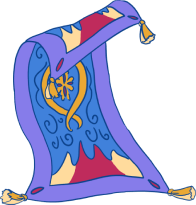
EPISODE 3
Helen Caddick
Sipho and Grandad visit a heritage house inspired by Indian cultural heritage, Sipho spots what looks like a prayer mat and tapestry. Learn the history of carpet weaving in India with Sipho and Grandad.
“Another day out with Grandad. I’m really excited, as we are visiting a building called an archive. Grandad wants to show me the diary of a female traveller and photographer called Helen Caddick. He says there’s a lot I need to know about explorers and the expansion of the British empire. I can’t wait!”.
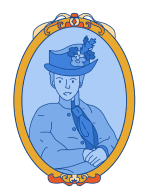
Welcome to
ABOUT THE PROJECT
Each episode previews a national dish on the end credits, the curator’s very own marvel surprise. Why not travel the world in your kitchen?
Want to utilise Learning with Grandad at school? We’ve got you covered with a collection of learning resources tailor-made to aid you in the classroom.
SANNE CHIZA BLANCO
Sanne, a fine art graduate explores concepts of nostalgia, memory as well as her Spanish – Ecuadorian heritage. Sanne’s recent installation was inspired by family photographs taken in Ecuador, Ecuadorian fabrics, instruments and ornaments sent to the UK by her family. The installation featured large portraits of her aunties dressed in traditional attire standing and gazing directly at the audience. Sanne aimed to take up space and bring visibility to a culture that is not widely recognised in Britain.
In her recent work with We Don’t Settle she finds interest in developing ways to encourage children to interact with exhibitions through animation. She especially enjoyed building the characters of Sipho and Grandad because it was an opportunity to design a new world, bringing creativity to non fiction. She aspires to produce more work centred around character and world building.
EDWARD WILLIAMS
Edward is an artist that works with drawing, painting and printing mediums. This is to create conversations around our current reality and practices. Edward’s recent art piece uses mark-making, painting methodologies to depict environmental locations such as cityscapes in Wolverhampton. He wanted to push the boundaries on what art could be and look like.
Alongside his artistic practices, Edward has been working with underrepresented communities to present cultural artefacts to the general public. This has been a fantastic journey of learning and discovery for Edward, he feels that work such as this will enable conversations around different cultural artefacts to be discussed in schools, and other institutions rather than buried in museum collections. Edward aspires to curate exhibitions that represent historical artefacts from diverse communities.
NOMPUMELELO NCUBE (NOM)
Nompumelelo is Freelance Creative producer for We Don’t Settle who facilitated the curator programme. She is a photojournalist passionate about the social mobility and visibility of marginalised communities in media, visual arts and the heritage sector. Her specialism is in representation. She investigates the correlation between representation and self-image, her research and photographic work explore identity, culture and dress. She aims to marry academic discourse in the politics of representation with storytelling. She is passionate about coproduction and collaborative methodologies in storytelling.
GABRIELA BRAN
Gabriela Bran is an Animator working in various 2D/3D mediums, focusing on documentary and informative based work. She has produced her own narratives, music videos, and most recently she has projected animated backdrops for a theatrical performance in Rome. As well as filmmaking she has taught photography to young asylum seekers, enjoys painting, and running screen-based events.
We give special thanks to Gen Kelsang Khechog, from Jangchub Ling Kadampa Buddhist Centre and Birmingham Library Archive for their contributions to the research.
‘Learning with Grandad’ is part of We Don’t Settle’s Curator Programme, delivered in partnership with Wednesbury Museum and Art Gallery, Multistory, and funded by the National Heritage Lottery Fund. We welcome you to collaborate by sharing any stories you have about the cultural artefacts and topics featured in the episodes.

